service Oldsmobile Aurora 1998 s Service Manual
[x] Cancel search | Manufacturer: OLDSMOBILE, Model Year: 1998, Model line: Aurora, Model: Oldsmobile Aurora 1998Pages: 380, PDF Size: 19.75 MB
Page 282 of 380
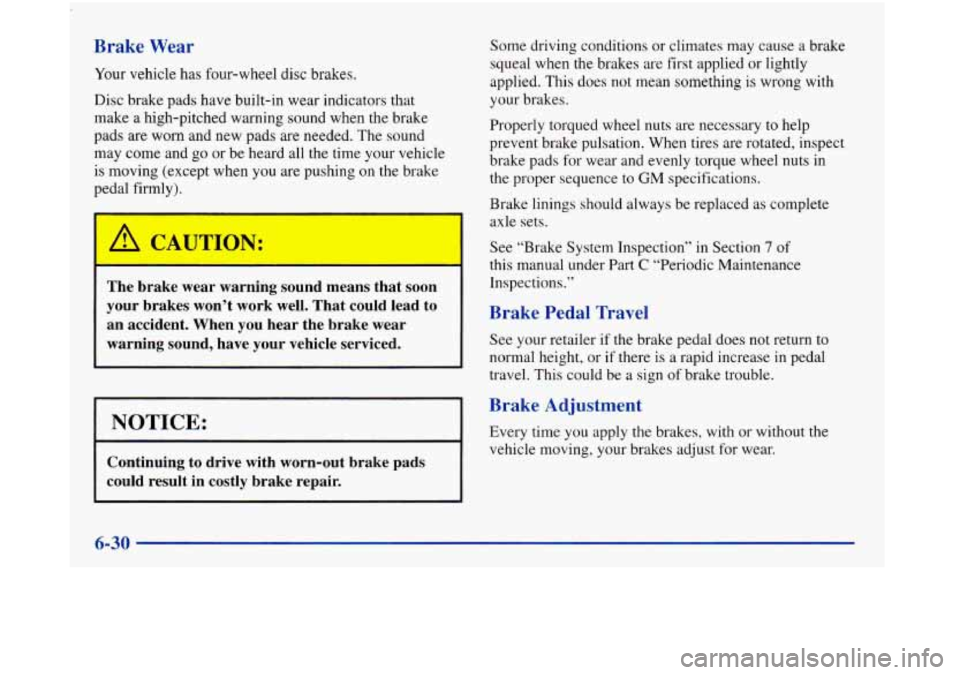
Brake Wear
Your vehicle has four-wheel disc brakes.
Disc brake pads have built-in wear indicators that
make a high-pitched warning sound when the brake
pads are worn and new pads
are needed. The sound
may come and go or be heard all the time your vehicle
is moving (except when you are pushing on the brake
pedal firmly).
A CAUTION:
The brake wear warning sound means that soon
your brakes won’t work well. That could lead
to
an accident. When you hear the brake wear
warning sound, have your vehicle serviced.
I NOTICE:
Continuing to drive with worn-out brake pads
could result in costly brake repair.
Some driving conditions or climates may cause a brake
squeal when the brakes
are first applied or lightly
applied.
This does not mean something is wrong with
your brakes.
Properly torqued wheel nuts
are necessary to help
prevent brake pulsation. When tires are rotated, inspect
brake pads for wear and evenly torque wheel nuts in
the proper sequence
to GM specifications.
Brake linings should always be replaced as complete
axle sets.
See “Brake System Inspection” in Section
7 of
this manual under Part
C “Periodic Maintenance
Inspections.”
Brake Pedal Travel
See your retailer if the brake pedal does not return to
normal height, or if there is a rapid increase in pedal
travel. This could be a sign of brake trouble.
Brake Adjustment
Every time you apply the brakes, with or without the
vehicle moving, your brakes adjust for wear.
6-30
Page 285 of 380
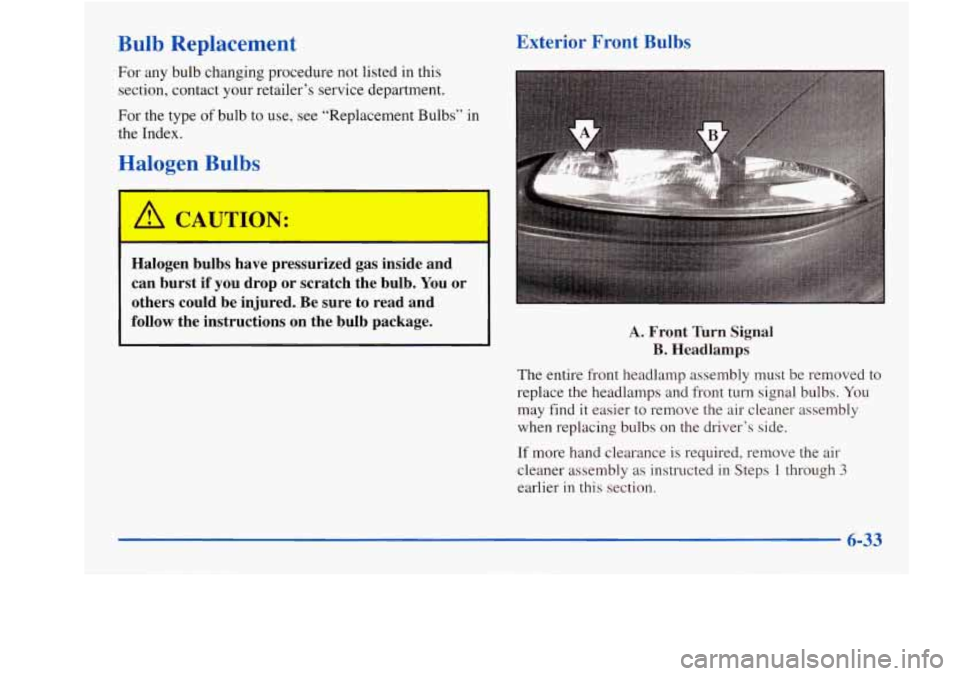
Bulb Replacement
For any bulb changing procedure not listed in this
section, contact your retailer’s service department.
For the type of bulb to use, see “Replacement Bulbs” in
the Index.
Halogen Bulbs
‘ A CAUTION:
A
Exterior Front Bulbs
1
Halogen bulbs have pressurized gas inside and
can burst if you drop or scratch the bulb. You or
others could be injured. Be sure to read and
follow the instructions on the bulb package.
A. Front Turn Signal
B. Headlamps
The entire front headlamp assembly must be removed to
replace
the headlamps and front turn signal bulbs. You
may find it easier
to remove the air cleaner assembly
when replacing bulbs on
the driver’s side.
If more hand clearance is required, remove the air
cleaner assembly as instructed in Steps 1 through
3
earlier in this section.
6-33
Page 295 of 380
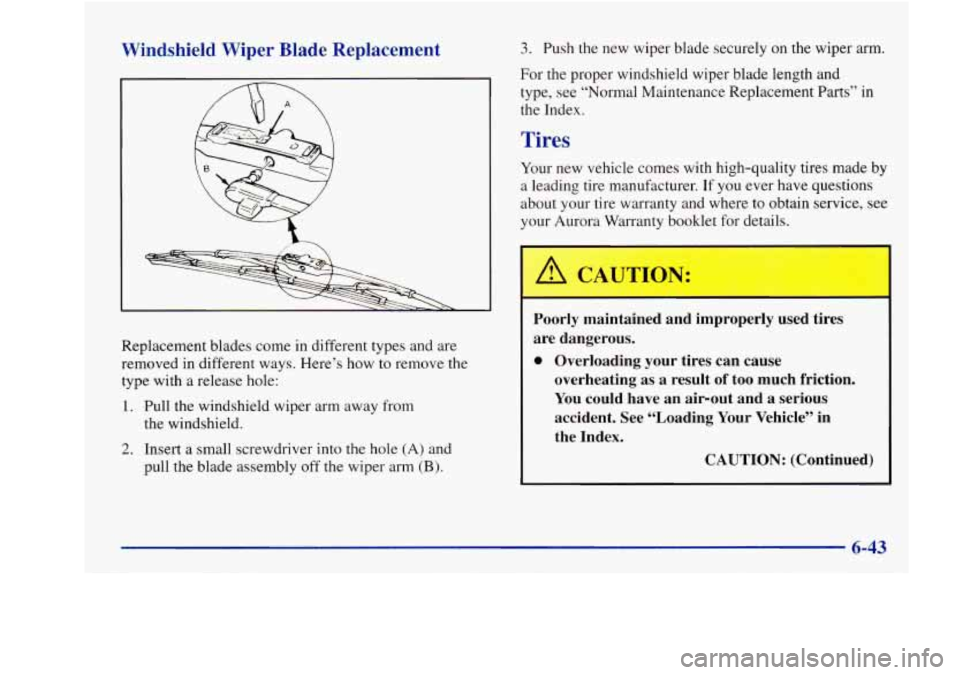
Windshield Wiper Blade Replacement
Replacement blades come in different types and are
removed in different ways. Here’s how
to remove the
type with a release hole:
1. Pull the windshield wiper arm away from
the windshield.
2. Insert a small screwdriver into the hole (A) and
pull the blade assembly
off the wiper arm (B).
3. Push the new wiper blade securely on the wiper arm.
For the proper windshield wiper blade length and
type, see “Normal Maintenance Replacement Parts” in
the Index.
Tires
Your new vehicle comes with high-quality tires made by
a leading tire manufacturer. If you ever have questions
about your tire warranty and where to obtain service, see
your Aurora Warranty booklet
for details.
Poorly maintained and improperly used tires
are dangerous.
0 Overloading your tires can cause
overheating as a result of
too much friction.
You could have an air-out and a serious
accident. See “Loading Your Vehicle” in
the Index.
CAUTION: (Continued)
Page 297 of 380

When to Check
Check your tires once a month or more.
Don’t forget your compact spare tire. It should be at
60 psi (420 Wa).
How to Check
Use a good quality pocket-type gage to check tire
pressure. You can’t tell if your tires are properly inflated
simply by looking at them. Radial tires may look
properly inflated even when they’re underinflated.
Be sure to put the valve caps back on the valve stems.
They help prevent leaks by keeping out dirt and moisture.
Tire Inspection and Rotation
Tires should be rotated every 6,000 to 8,000 miles
(10 000 to 13 000 km). Any time you notice unusual
wear, rotate your tires as soon as possible and check
wheel alignment. Also check for damaged tires or wheels.
See “When It’s Time for New Tires” and
“Wheel
Replacement” later in this section for more information.
The purpose
of regular rotation is to achieve more
uniform wear for all tires on the vehicle. The first
rotation is the most important. See “Scheduled
Maintenance Services” in the Index for scheduled
rotation intervals. When
rotating your tires, always use the correct
rotation pattern shown here.
Don’t include the compact spare tire in your
tire rotation.
After the tires have been rotated, adjust the front and
rear inflation pressures as shown
on the Tire-Loading
Information label. Make certain that all wheel nuts
are properly tightened. See “Wheel Nut Torque” in
the Index.
Page 299 of 380
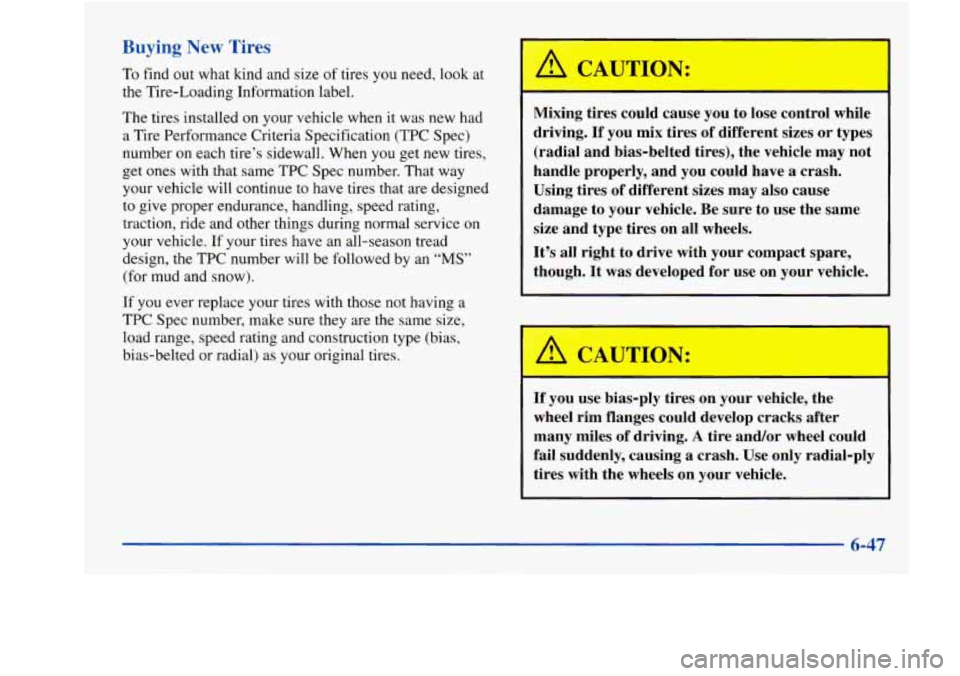
Buying New Tires
To find out what kind and size of tires you need, look at
the Tire-Loading Information label.
The tires installed on your vehicle when it was new had
a Tire Performance Criteria Specification (TPC Spec)
number on each tire’s sidewall. When you get new tires,
get ones with that same TPC Spec number. That way
your vehicle will continue to have tires that are designed
to give proper endurance, handling, speed rating,
traction, ride and other things during normal service
on
your vehicle. If your tires have an all-season tread
design, the
TPC number will be followed by an “MS”
(for mud and snow).
If you ever replace your tires with those not having a
TPC Spec number, make sure they are the same size,
load range, speed rating and construction type (bias,
bias-belted or radial) as your original tires. Mixing tires could cause
you to
lose control while
driving.
If you mix tires of different sizes or types
(radial and bias-belted tires), the vehicle may not
handle properly, and you could have
a crash.
Using tires of different sizes may also cause
damage to your vehicle. Be sure to use the same
size and type tires on all wheels.
It’s all right to drive with your compact spare,
though. It was developed for use on your vehicle.
If you use bias-ply tires on your vehicle, the
wheel rim flanges could develop cracks after
many miles of driving.
A tire and/or wheel could
fail suddenly, causing a crash. Use only radial-ply
tires with the wheels on your vehicle.
6-47
Page 300 of 380
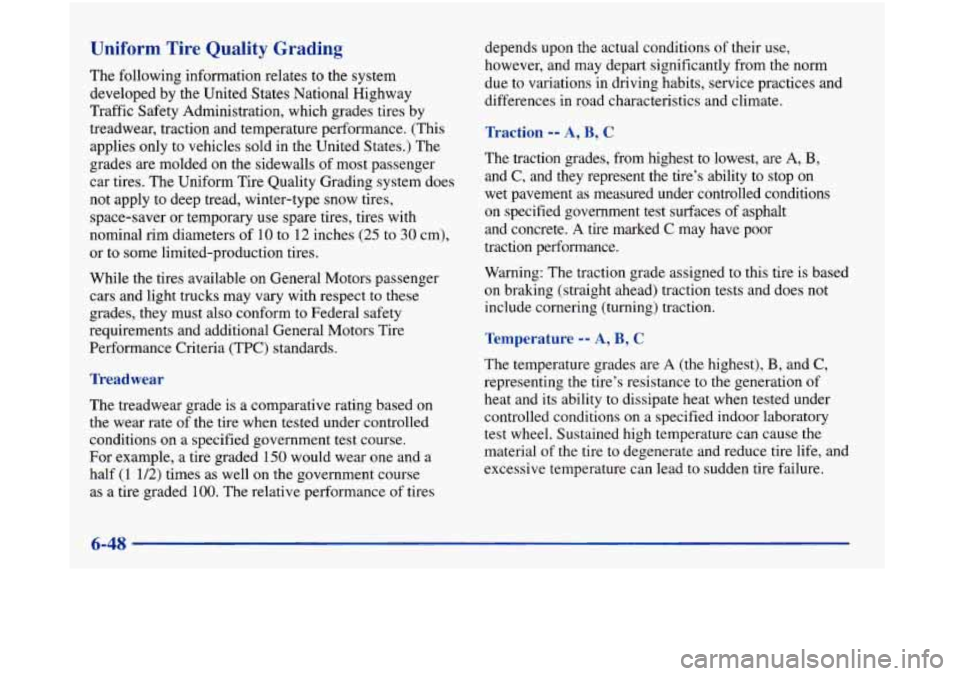
Uniform Tire Quality Grading
The following information relates to the system
developed
by the United States National Highway
Traffic Safety Administration, which grades tires by
treadwear, traction and temperature performance. (This applies only to vehicles sold in the United States.) The
grades are molded on the sidewalls of most passenger
car tires. The Uniform Tire Quality Grading system does
not apply to deep tread, winter-type snow tires,
space-saver or temporary use spare tires, tires with
nominal rim diameters of 10 to 12 inches (25 to
30 cm),
or to some limited-production tires.
While the tires available on General Motors passenger
cars and light trucks may vary with respect to these
grades, they must also conform to Federal safety
requirements and additional General Motors Tire
Performance Criteria (TPC) standards.
Treadwear
The treadwear grade is a comparative rating based on
the wear rate
of the tire when tested under controlled
conditions on a specified government test course.
For example, a tire graded
150 would wear one and a
half (1 1/2) times as well on the government course
as a tire graded 100. The relative performance of tires depends upon
the actual conditions of their use,
however, and may depart significantly from the norm
due to variations in driving habits, service practices and
differences in road characteristics and climate.
Traction -- A, B, C
The traction grades, from highest to lowest, are A, B,
and C, and they represent the tire’s ability to stop on
wet pavement as measured under controlled conditions
on specified government test surfaces
of asphalt
and concrete.
A tire marked C may have poor
traction performance.
Warning: The traction grade assigned to this tire is based
on braking (straight ahead) traction tests and does not
include cornering (turning) traction.
Temperature -- A, B, C
The temperature grades are A (the highest), B, and C,
representing the tire’s resistance to the generation of
heat and its ability
to dissipate heat when tested under
controlled conditions on a specified indoor laboratory
test wheel. Sustained high temperature can cause the
material of the tire to degenerate and reduce tire life, and
excessive temperature can lead to sudden tire failure.
6-48
Page 309 of 380

Finish Damage
Any stone chips, fractures or deep scratches in the finish
should be repaired right away. Bare metal will corrode
quickly and may develop into a major repair expense.
Minor chips and scratches can be repaired with touch-up
materials available from your retailer or other service
outlets. Larger areas
of finish damage can be corrected
in your retailer’s body and paint shop.
Underbody Maintenance
Chemicals used for ice and snow removal and dust
control can collect on the underbody. If these are not
removed, accelerated corrosion (rust) can occur on
the underbody parts such as fuel lines, frame, floor
pan and exhaust system even though they have
corrosion protection.
At least every spring, flush these materials from the
underbody with plain water. Clean any areas where mud
and other debris can collect. Dirt packed in closed areas
of the frame should be loosened before being flushed.
Your retailer or an underbody car washing system can
do this for you.
Chemical Paint Spotting
Some weather and atmospheric conditions can create
a chemical fallout. Airborne pollutants can fall upon
and attack painted surfaces on your vehicle. This
damage can take two forms: blotchy, ringlet-shaped
discolorations, and small irregular dark spots etched
into the paint surface.
Although no defect in the paint job causes this,
Oldsmobile will repair, at no charge to the owner, the
surfaces of new vehicles damaged by this fallout
condition within 12 months or 12,000 miles
(20 000 km)
of purchase, whichever occurs first.
Page 311 of 380

Vehicle Identification Number (VIN)
IIrnlllllI
I
111 111111 IIII 11l1111111111I IIIIIIII 11111111 1111IIII I IIIIIII
I
ENGlNEA698 7 ASSEMBLY
CODE
MODEL YEAR PLANT
This is the legal identifier for your vehicle. It appears on
a plate in the front corner of the instrument panel, on the
driver’s side. You can see
it if you look through the
windshield from outside your vehicle. The
VIN also
appears on the Vehicle Certification and Service Parts
labels and the certificates of title and registration.
Engine Identification
The 8th character in your VIN is the engine code. This
code will help
you identify your engine, specifications
and replacement parts.
Service Parts Identification Label
You’ll find this label on the underside of the spare tire
cover. It’s very helpful if you ever need to order parts.
On this label is:
0 your VIN,
0 the model designation,
paint information and
a list of all production options and special
equipment.
Be sure that this label is not removed from the vehicle.
Page 322 of 380
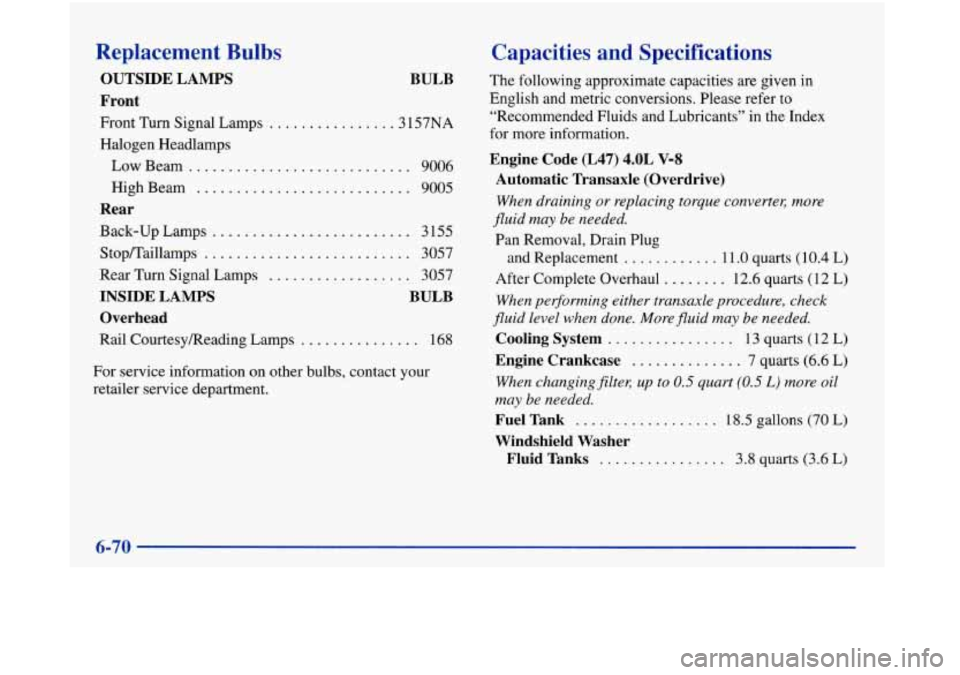
Replacement Bulbs
BULB
OUTSIDE LAMPS
Front
Front
Turn Signal Lamps ............... .3 157NA
Halogen Headlamps
Low Beam
............................ 9006
High Beam
........................... 9005
Rear
Back-up Lamps ......................... 3 155
StopKaillamps
.......................... 3057
Rear
Turn Signal Lamps .................. 3057
INSIDE LAMPS BULB
Overhead
Rail CourtesyReading Lamps ............... 168
For service information on other
bulbs, contact your
retailer service department.
Capacities and Specifications
The following approximate capacities are given in
English and metric conversions. Please refer to
“Recommended Fluids and Lubricants” in the Index
for more information.
Engine Code (L47) 4.0L V-8
Automatic Transaxle (Overdrive)
When draining or replacing torque converteq more
fluid may be needed.
Pan Removal, Drain Plug
and Replacement
............ 11 .O quarts (10.4 L)
After Complete Overhaul
........ 12.6 quarts (12 L)
When per$orming either transaxle procedure, check
fluid level when done. More fluid may be needed.
Cooling System ................ 13 quarts (12 L)
Engine Crankcase .............. 7 quarts (6.6 L)
When changingfllteq up to 0.5 quart (0.5 L) more oil
may be needed.
Fuel Tank .................. 18.5 gallons (70 L)
Windshield Washer
Fluid Tanks
................ 3.8 quarts (3.6 L)
6-70
Page 327 of 380

@ Section 7 Maintenance Schedule
This section covers the maintenance required for your Aurora. Your vehicle needs these services to retain its safety,
dependability and emission control performance.
7-2
7-3
7-4
7-4
Introduction
How this Section is Organized
Part A: Scheduled Maintenance Services
Using Your Maintenance Schedule 7- 14 Part B: Owner Checks and Services
7- 18 Part C: Periodic Maintenance Inspections
7-20 Part
D: Recommended Fluids and Lubricants
7-22 Part
E: Maintenance Record